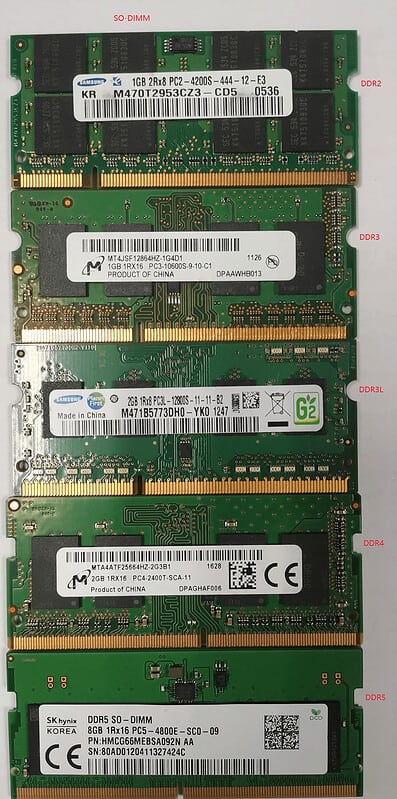Introduction: With the increasing variety of computer memory, it’s likely that many people are unsure about how to identify the type of memory module in their laptops or desktops. The market offers numerous memory types including DDR, DDR2, DDR3, DDR3L, DDR4, DDR5, LPDDR, LPDDR2, LPDDR3, LPDDR4, LPDDR4X, and LPDDR5. But what do they actually look like?
This article won’t delve into methods using operating system interface information; instead, it will focus on methods based on voltage and physical characteristics.
Memory modules are generally installed in computers. RDIMM is common for servers, UDIMM for desktops, and SODIMM for laptops. Of course, some motherboards have memory chips directly mounted, which is LPDDR.
Voltage Distinction: Voltage varies across the first to fifth generations #
- DDR (1st generation DDR): 2.5V
- DDR2: 1.8V
- DDR3: 1.5V
- DDR3L: 1.35V (Physically identical to DDR3 modules, compatible notches; DDR3 slot can accommodate DDR3L)
- DDR4: 1.2V
- DDR5: 1.1V
Physical Form Distinction: The gold contact notch position varies across the first to fifth generations, and they are not cross-compatible #
Differentiating Desktop and Laptop Memory Modules: Desktop memory modules are longer than laptop memory modules, which is the most noticeable distinction.
When you have a memory module (Advantages of Dual Channel Memory) in hand, how do you know which DDR generation it belongs to? Many memory modules don’t directly label their DDR generation; instead, they are labeled with a PC number.
The PC number corresponds to the DDR generation
DDR: This one doesn’t have a clear label since it’s the first generation and standards weren’t as established then.
- DDR2: PC2
- DDR3: PC3
- DDR3L: PC3L
- DDR4: PC4
- DDR5: PC5 (Unveiling DDR5: Enhanced Performance, Lower Power Usage)
Additionally, the gold contacts of DDR, DDR2, DDR3, and DDR3L are in a straight line, while DDR4 and DDR5 have curved gold contacts.
I have collected memory modules from each generation and compiled the following valuable images to illustrate the differences between each generation of DDR.
(1) Desktop Memory Modules (Unbuffered DIMM): The images from top to bottom represent DDR, DDR2, DDR3, DDR4, and DDR5.

(2) Laptop Memory Modules (SO-DIMM, Small Outline DIMM): The images from top to bottom represent DDR2, DDR3, DDR3L, DDR4, and DDR5.
Because laptops came after desktops, it seems there isn’t a first-generation DDR for laptops.

(3) Memory Chip Form LPDDR Modules:
It’s difficult to visually determine the LPDDR generation from the physical appearance of memory chips. It can only be distinguished through system configuration information or chip model numbers.
Related:






